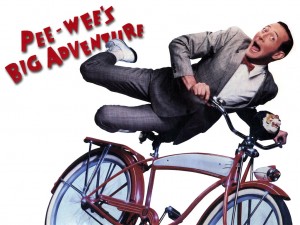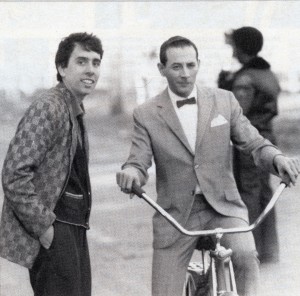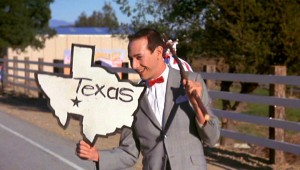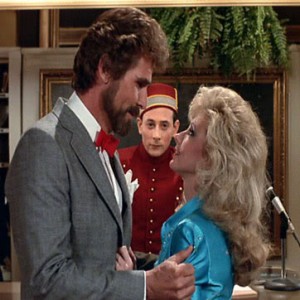100 Film Favorites – #15: Pee-Wee’s Big Adventure
(Tim Burton, 1985)
“I’m a loner, Dottie. A rebel. You don’t wanna get mixed up with a guy like me.”
Ah, the directorial debut. To be sure, some directors gradually climb the studio ladder, and their freshman efforts in the director’s chair may not be particularly impressive or memorable. But sometimes, a director’s first film bursts onto the scene, showcasing a new look or innovative style of cinematic story-telling, and notifying the entire industry that someone new is in town. George Romero’s Night of the Living Dead. Tobe Hooper’s Texas Chainsaw Massacre. Quentin Tarantino’s Reservoir Dogs. Hal Warren’s Manos: The Hands of Fate.
Well, I can dream.
Tim Burton is a weird dude, and his directorial debut, Pee-Wee’s Big Adventure, perfectly sets the stage for what was to come in Burton’s surreal, off-kilter, vaguely spooky, and altogether unconventional career.
The film stars Paul Reubens as Pee-Wee Herman, a character Reubens created while a member of the Groundlings, an L.A.-based improv troupe. A zany man-child styled after 50s children’s show hosts like Pinky Lee, Pee-Wee inhabits a kitsch wonderland populated by puppets, Pee-Wee’s genie servant, Jambi, and the occasional human friend (one of the first human visitors was fellow Groundling performer Phil Hartman, as the salty seaman Captain Carl). Reubens built a stage show around the character, and in 1981, a televised broadcast of The Pee-Wee Herman Show proved a modest hit for HBO. Pee-Wee gained wider popularity through appearances on Late Night with David Letterman, and by the mid-80s Reubens was in talks with Warner Brothers to create a feature film around the character.
Tim Burton began his career as a Disney animator in the early 80s (alongside CalArts classmates like John Lasseter). In addition to animation work, Burton helmed some short side-projects, including the stop-motion film Vincent, about a boy who imagines himself to be horror icon Vincent Price, and Frankenweenie, about a scientifically-minded youngster who emulates Frankenstein by resurrecting his dead dog in a lightning storm. After Disney deemed Frankenweenie too scary for their target audience of children, Burton was fired in 1984. (Ironically, Burton would direct a feature-length remake of the same film for Disney 18 years later).
The kooky sensibility displayed in Vincent and Frankenweenie brought Burton to Reubens’ attention, and he was brought on board to direct the Warner Bros.’ Pee-Wee project. Made for a budget of $8 million, the movie went on to gross more than $40 million, cementing Burton’s reputation as a director with a penchant for giving life to the charmingly bizarre.
Reubens has stated he was inspired to write the script for Big Adventure after visiting the Warner studio and realizing that everyone who worked there relied on bicycles to zip around the lot, and he would only really be a part of the studio once he had a bike of his own. The film follows Pee-Wee, an eccentric “boy” obsessed with maintaining his most treasured possession – a highly-customized red-and-white Schwinn bicycle. One “typical” morning, Pee-Wee begins his day with a series of quirky activities: sitting down to a breakfast of Mr. T Cereal and pancakes prepared via Rube Goldberg “breakfast machine,” hobnobbing with pals like “Amazing Larry” at a local magic shop, and visiting “Chuck’s Bike-o-rama” to pick up an upgraded bicycle horn (the shop’s mechanic, Dottie, is sweet on Pee-Wee, but he mostly ignores her).
But trouble is brewing beneath the surface of Pee-Wee’s idyllic world. Pee-Wee’s rival, spoiled rich “kid” Francis Buxton, covets Pee-Wee’s prized bike, and initially attempts to buy it from him. When Pee-Wee refuses, Buxton covertly hires a thug to steal the cycle. Emerging from Chuck’s shop to find himself bike-less, Pee-Wee is distraught. He immediately heads to the Buxton mansion, where he attacks Francis in the “tub” (a lavish swimming pool). Francis denies having taken the bike, and Pee-Wee is escorted off the premises. Spooked by the encounter, Francis commands his hired goon to dispose of the bike, saying he “doesn’t want it anymore.”
Unsure of where to turn next, Pee-Wee wanders the dark, rainy alleys of the city, until he comes to a fortune teller. “Madame Ruby,” pulling inspiration from random bits of text scattered around her office, advises Pee-Wee that the lost treasure he seeks is located “at the Alamo…in the basement.” Overjoyed, Pee-Wee sets off for Texas. In a well-executed bit of dramatic irony, we see the car in which Pee-Wee has hitched a ride veer one direction at a fork in the road, only to reveal that a junk truck laden with his bike is headed the other way.
So begins an epic, surreal journey. It’s rather like the standard “road movie,” if it were made by…well, if it were made by Tim Burton. In his travels, Pee-Wee encounters all manner of strange characters and situations. He hitches rides with everyone from a fugitive convict who claims to have cut the “do not remove” tag from a mattress to Large Marge, a lady trucker who reveals herself to be a hideously mutilated ghost (realized through the spooktacular wonders of Claymation). He even has a chance to wax poetic to a waitress on the necessity of following one’s dreams, as they watch the sun rise through the jaws of an enormous roadside T-Rex statue. All the while, Pee-Wee is spurred on in his quest by a recurring nightmare, wherein evil clowns do horrible things to his bike.
After reaching San Antonio and discovering that “the Alamo was built without a basement…some things you just don’t learn in school,” Pee-Wee nearly gives up hope. That is, until he sees a news story about a child star in California who is now in possession of the bike and plans to feature it in an upcoming film. Pee-Wee journeys to (surprise!) the Warner Bros. studio lot, and reclaims the bike from the snotty kid (Jason Hervey, AKA Kevin’s obnoxious older brother Wayne from The Wonder Years).
Pee-Wee flees studio security, racing through one film set after another, including a Godzilla-like kaiju film, a Tarzan movie, a beach party film, and even a Twisted Sister music video. Amidst the chaos, Pee-Wee very nearly escapes…but then he spots a pet shop on fire. Putting his quest on hold, he busts into the shop and rescues all the animals (even the snakes, though he puts off this task as long as possible). Finally, he passes out curbside from smoke inhalation, and is apprehended. Rather than a prisoner, Pee-Wee awakens to find himself a hero. Warner Bros. executives approach him and offer to buy the movie rights to his life story and the epic search for his bike.
In the final scene, Pee-Wee and Dottie attend a Drive-In premiere of the movie, which has been “adapted” into a James Bond-style spy thriller starring James Brolin as “P.W. Herman” and Morgan Fairchild as Dottie. As he walks through the parking lot to the concession stand, Pee-Wee greets his various friends and traveling companions, all of whom have come out for the screening. Amazing Larry, Chuck, Simone the waitress, and even his convict buddy (watching from a prison bus) are there, and congratulate Pee-Wee on his Hollywood debut. Pee-Wee sticks around long enough to see his own cameo at the start of the film (he appears as a bellhop with someone else’s baritone voice awkwardly dubbed over his own). When he gets up to leave, Dottie asks why he doesn’t want to see the rest of the film, Pee-Wee replies, “I don’t need to see it. I lived it.” The two bicycle away into the distance, their silhouettes crossing behind the drive-in screen.
As I warned a few posts ago, now that we’re into the Top 15 posts, it’s going to be difficult for me to offer much commentary besides “I. LOVE. THIS. MOVIE.” Big Adventure is just that: a big, rollicking adventure that’s fun from beginning to end. Sure, it’s episodic, but every segment is dripping with a mix of kooky, Burtonian weirdness and Pee-Wee’s own unique “twisted 50s” aesthetic. The way the film progresses feels almost “stream of consciousness” style, but in a good way. You never know what’s coming next. And even once you’ve seen it, and DO know what’s coming next, it’s so strangely hilarious that this is one Big Adventure that can be enjoyed again and again.
Tidbits:
–Pee-Wee’s Playhouse, perhaps Reubens’ most well-known contribution to popular culture, debuted in 1986, roughly a year after the release of Big Adventure. A children’s television program, the series returned to the format of the HBO Pee-Wee Herman Show, albeit with less overtly adult humor.
-The scene in which Pee-Wee and Simone watch the sunrise was filmed at the iconic roadside attraction known as the Cabazon Dinosaurs, also featured in 1989’s The Wizard. 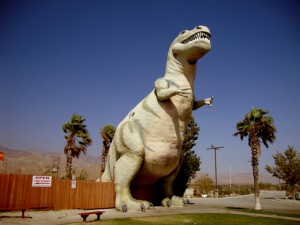
-In addition to being Tim Burton’s directorial debut, this film also marked his first collaboration with songwriter / composer Danny Elfman of the band Oingo Boingo. Elfman would go on to score nearly every Tim Burton project to date (coincidentally, the two he didn’t are both still upcoming in this Countdown).
—
Brian Terrill is the host of television show Count Gauntly’s Horrors from the Public Domain. You can keep up with Brian’s 100 Film Favorites countdown here.


